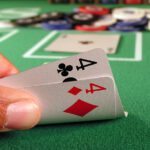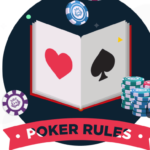One big lesson to learn, in any poker game, is to never look at your hand first. If for example you are playing 7 card stud, look at the reactions when your opponents look at their final face down card before you see yours. The same goes for Texas Hold’em. It helps a lot more to wait until it is your turn to act before looking at your hand, but more importantly to look at everyone else as they look at their hand first. You can pick up a lot from watching their reactions the first time they look at their cards.
Double Check
A double check is re-looking at your hand after you have already seen it. Depending on the situation or the game, it can vary what this may mean. In a game like stud where you have hidden hole cards and shown cards, it could mean that the player started with a pair and checked to see if the next card made him two pair. In my experience in Texas Hold’em, a double check is usually not a strong hand. If someone looks and sees two aces, they know what it is and generally only give it one look.
Uninterested, Look Away
Picking up on this tell is picking up on the deception that people feel they need to act in order to get paid off. Of course, most people don’t realize that these actions that naturally occur are very large tells. In this case, if someone looks at their hand, sets it down uninterested then looks away, you can be certain they just looked at a monster. As Caro says, “In their attempt to deceive you, players usually stare longer at cards that are bad then cards that are good. And they look away because they are trying to act uninterested.” I could not agree more, and this is one of the reasons I think it is a very good idea to look at everyone else before looking at your own cards. You can pick up some valuable information about how someone looks at their hand, and you might not notice this if you are looking at your own before it is your turn.
Glance Back
When player’s glance back at their hand when the flop comes out monotone (3 hearts for example), you can almost be certain that they did not flop a flush. Instead, what it probably means is that they have one of that suit. This can be very helpful because you probably do not have the worry about the flush unless a fourth heart comes out on the turn or river. Most of the time if a player is dealt two of the same suit, they will remember what suit is in their hand. However, if they are dealt two off suit cards they usually have to look back to see if they have one of them in their hand. Depending on how they look back at their hand can also tip off if they actually have a high card of that suit. Generally, if they look quickly then close their hand, they probably do have it. If they continue to stare or look a few times, they most likely do not. One of the biggest thing you should get from this is you should not be worried about the flopped flush.
Final Card Look
This is a brilliant tell to learn to pick up on. Depending on how your opponent looks back at their hand can help you determine the strength of it. Caro talks about the degree of suspense, “Player’s who look at cards are either looking at them because of a lot of suspense involved, or a little suspense.” What he means by this is if someone already had a made hand that they think is good, like 2 pair in 5 card draw, there will be little suspense to look at that last card. They will most likely just pick it up and look at it quickly. However, if someone was drawing to a flush, there is a lot of suspense involved since it is basically “all or nothing,” since they have nothing to fall back on. They will most likely look at the card slower since it is more dramatic for their hand. This is also the same for hold’em as well. If for example the river hits, the speed of your opponents reaction or how long they stare at that card, can determine if it improved their hand.
Although not as common, this can also be attributed to how people look at their cards preflop in hold’em. If you notice someone that looks at one card before they look at their second, this can be an advantage for you. For example, if they look at their first card then immediately look at their second; you can probably assume that the first card wasn’t very good. However, if they look at their first card, then take a moment to squeeze out the next, this is probably because the first card was something good; probably an ace.
Quick Look
As stated above, the degree of suspense is present in many players by nature. If they get dealt their last card in a draw game and quickly look at it, they probably already had a hand. In the same area, if they toss it down quickly, it probably also improved their hand as well.
Shuffle for Flush
This mainly applies to draw poker, or games like 7 card stud where people have more than two cards. If you notice someone draw one card, then look at it and shuffle their cards, like they are putting them in order, they probably hit their straight or flush. Caro says there is one rule with this, “a player who shuffles cards looking for a straight or a flush, will almost never bluff.”
Shuffle or Not
This extends off the concept above, and also to the suspense factor. If you are in a draw game, and a player draws one card, then shuffles it in with his cards before looking at it, you can assume he was drawing. It could be a flush or straight draw, but most of the time he will not already have a made hand. This is a concept that Caro mentions many times and tries to make it perfectly clear that when someone has a drawing hand they tend to squeeze out the look rather that quickly looking.
Watching the Flop
How someone reacts to the flop can really help you pick up information about their hand. So in order to notice this, you should not look at the flop yourself. As Caro states, “When the flop comes, the biggest mistake you can do is watch it. That flop isn’t going to change and those cards will still be there.” Now there are two major things you should look for while watching people’s reactions. First off, when the flop comes out, if your opponent continues to stare at it, it is likely that he missed or is not very strong. Part of this was mentioned earlier, people with weak cards usually continue to stare at them. Now the second and most important tell to look for is the one where they immediately look away from the flop. This is something that is fairly easy to notice and almost always indicates they hit some piece of the flop. A lot of the time, they will look away and immiediately look at their chip stack. Now if you see this happen, it makes your decision easier if you should bet into them.
Caro says that watching how people react to the flop is one of the “greatest hold’em tells of all time.” One of his laws of tells states, “A player glances secretly at his chips only when he’s considering a bet – and almost always because he’s helped his hand.”
Submit your review | |










